Lunokhod 1
Lunokhod 1 (Russian: Луноход-1 "Moonwalker 1"), also known as Аппарат 8ЕЛ № 203 ("Device 8EL No. 203") was the first robotic rover on the Moon and the first to freely move across the surface of an astronomical object beyond the Earth.[1] Sent by the Soviet Union it was part of the robotic rovers Lunokhod program. The Luna 17 spacecraft carried Lunokhod 1 to the Moon in 1970. Lunokhod 0 (No.201), the previous and first attempt to land a rover, launched in February 1969 but failed to reach orbit.
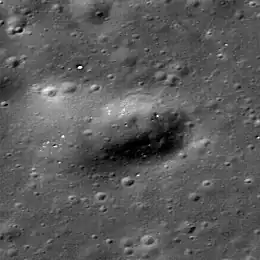 Leonid crater, near Luna 17 landing site, Mare Imbrium, the moon. The final resting place of the Lunokhod-1 rover is in upper left. | |
| Mission type | Lunar rover |
|---|---|
| COSPAR ID | 1970-095A |
| Website | Lunar and Planetary Department Moscow University Lunokhod 1 page |
| Spacecraft properties | |
| Launch mass | 5,600 kilograms (12,300 lb) |
| Dry mass | 756 kilograms (1,667 lb) (rover only) |
| Power | 180 watts |
| Start of mission | |
| Launch date | November 10, 1970 |
| Rocket | Proton-K/D |
| Launch site | Baikonur 81/23 |
| End of mission | |
| Last contact | September 14, 1971 |
| Lunar rover | |
| Spacecraft component | Rover |
| Landing date | November 17, 1970, 03:47:00 UTC |
| Landing site | 38.2378°N 35.0017°W |
Although only designed for a lifetime of three lunar days (approximately three Earth months), Lunokhod 1 operated on the lunar surface for eleven lunar days (321 Earth days) and traversed a total distance of 10.54 km.[2]
Rover description
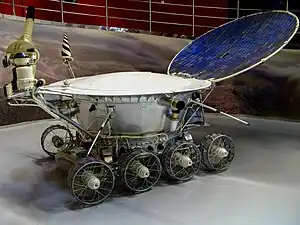
Lunokhod 1 was a lunar vehicle formed of a tub-like compartment with a large convex lid on eight independently powered wheels. Its length was 2.3 metres (7 ft 7 in).
Lunokhod 1 was equipped with a cone-shaped antenna, a highly directional helical antenna, four television cameras, and special extendable devices to test the lunar soil for soil density and mechanical properties.
An X-ray spectrometer, an X-ray telescope, cosmic ray detectors, and a laser retro-reflector (supplied by France[3]) were also included.
The vehicle was powered by batteries which were recharged during the lunar day by a solar cell array mounted on the underside of the lid. To be able to work in a vacuum, special fluoride-based lubricant was used for the mechanical parts, and the electric motors (one in each wheel hub) were enclosed in pressurized containers.[4][5]
During the lunar nights, the lid was closed, and a polonium-210 radioisotope heater unit kept the internal components at operating temperature.
Lunokhod 1 was intended to operate through three lunar days (approximately three Earth months), but actually operated for eleven lunar days.
Launch and lunar orbit
Luna 17 was launched on November 10, 1970, at 14:44:01 UTC. After reaching earth parking orbit, the final stage of Luna 17's launching rocket fired to place it into a trajectory towards the Moon (1970-11-10 at 14:54 UTC). After two course correction maneuvers (on November 12 and 14), it entered lunar orbit on November 15, 1970, at 22:00 UTC.
Landing and surface operations
The spacecraft soft-landed on the Moon in the Mare Imbrium (Sea of Rains) on November 17 at 03:47 UTC. It landed in western Mare Imbrium, about 60 km south of the Promontorium Heraclides. The lander had dual ramps from which the payload, Lunokhod 1, could descend to the lunar surface.
At 06:28 UTC the rover moved onto the Moon's surface. The rover would run during the lunar day, stopping occasionally to recharge its batteries via the solar panels. At night the rover hibernated until the next sunrise, heated by the radioactive source.
Small craters along its traverse were named unofficially during the mission. The names were officially approved by the IAU in 2012.[6] They are called Albert, Leonid, Kolya, Valera, Borya, Gena, Vitya, Kostya, Igor, Slava, Nikolya, and Vasya.
Operations during 1970:
- November 17–22: The rover drove 197 m, returned 14 close-up pictures of the Moon and 12 panoramic views, during 10 communication sessions. It also conducted analyses of the lunar soil.
- December 9–22: 1,522 m
Operations during 1971:
- January 8–20: 1,936 m
- February 8–19: 1,573 m
- March 9–20: 2,004 m
- April 8–20: 1,029 m
- May 7–20: 197 m
- June 5–18: 1,559 m
- July 4–17: 220 m
- August 3–16: 215 m
- August 31 – September 14: 88 m
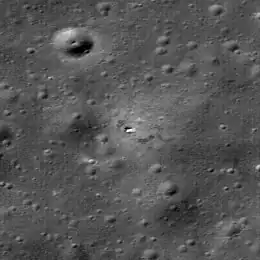 Luna 17 imaged by the Lunar Reconnaissance Orbiter in 2010
Luna 17 imaged by the Lunar Reconnaissance Orbiter in 2010 Lunokhod 1 panorama
Lunokhod 1 panorama
End of mission and results
Controllers finished the last communications session with Lunokhod 1 at 13:05 UT on September 14, 1971. Attempts to re-establish contact were finally discontinued and the operations of Lunokhod 1 officially ceased on October 4, 1971, the anniversary of Sputnik 1. During its 322 Earth days of operations, Lunokhod 1 travelled 10,540 metres (6.55 miles) and returned more than 20,000 TV images and 206 high-resolution panoramas. In addition, it performed 25 lunar soil analyses with its RIFMA x-ray fluorescence spectrometer and used its penetrometer at 500 different locations.
Current location
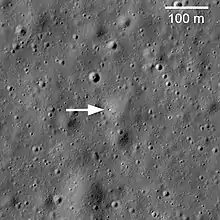
The final location of Lunokhod 1 was uncertain until 2010, as lunar laser ranging experiments had failed to detect a return signal from it since 1971. On March 17, 2010, Albert Abdrakhimov found both the lander and the rover[7] in Lunar Reconnaissance Orbiter image M114185541RC (Line 21977, Sample 3189).[8] In April 2010, the Apache Point Observatory Lunar Laser-ranging Operation (APOLLO) team from the University of California at San Diego used the LRO images to locate the rover closely enough for laser range (distance) measurements. On April 22, 2010, and days following, the team successfully measured the distance several times. The intersection of the spheres described by the measured distances then pinpoint the current location of Lunokhod 1 to within 1 meter.[9][10] APOLLO is now using Lunokhod 1's reflector for experiments, as they discovered, to their surprise, that it was returning much more light than other reflectors on the Moon. According to a NASA press release, APOLLO researcher Tom Murphy said, "We got about 2,000 photons from Lunokhod 1 on our first try. After almost 40 years of silence, this rover still has a lot to say."[11]
By November 2010, the location of the rover had been determined to within about a centimeter. The location near the limb of the Moon, combined with the ability to range the rover even when it is in sunlight, promises to be particularly useful for determining aspects of the Earth–Moon system.[12]
In a report released in May 2013, French scientists at the Côte d'Azur Observatory led by Jean-Marie Torre reported replicating the 2010 laser ranging experiments by American scientists after research using images from the NASA Lunar Reconnaissance Orbiter. In both cases, laser pulses were returned from the Lunokhod 1 retroreflector.[13]
Gallery
.jpg.webp) Lunokhod 1 in the Museum of Cosmonautics (Moscow)
Lunokhod 1 in the Museum of Cosmonautics (Moscow)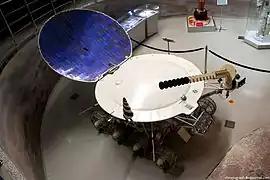 Top view of Lunokhod 1 model
Top view of Lunokhod 1 model Part of the Lunokhod 1 control panel. Museum of Space and Missile Technology (Saint Petersburg)
Part of the Lunokhod 1 control panel. Museum of Space and Missile Technology (Saint Petersburg) Part of the Lunokhod 1 control panel.
Part of the Lunokhod 1 control panel.
See also
References
- Siddiqi, Asif A. (2018). Beyond Earth: A Chronicle of Deep Space Exploration, 1958–2016 (PDF). The NASA history series (second ed.). Washington, DC: NASA History Program Office. p. 1. ISBN 9781626830424. LCCN 2017059404. SP2018-4041.
- Howell, Elizabeth (December 19, 2016). "Lunokhod 1: 1st Successful Lunar Rover", Space.com. Retrieved May 31, 2018.
- Leonard David (May 6, 2013). "Scientists Bounce Laser Beams Off Old Soviet Moon Rover". Space News.
- SVT2, Vetenskapens värld, "Den ryska månbilen", 080211 Archived 2008-06-02 at the Wayback Machine
- Synlube Lube-4-Life (Moon applications). synlube.com
- Borya, Gazetteer of Planetary Nomenclature, International Astronomical Union (IAU) Working Group for Planetary System Nomenclature (WGPSN)
- Lakdawalla, Emily (March 17, 2010). "And now for Luna 17 and Lunokhod 1". Planetary Report.
- "LROC Observation M114185541R". Arizona State University.
- McDonald, Kim (April 26, 2010). "UC San Diego Physicists Locate Long Lost Soviet Reflector on Moon". UCSD. Retrieved April 27, 2010.
- Klotz, Irene (April 27, 2010). "Lost and Found: Soviet Lunar Rover".
- Coulter, Dauna (June 3, 2010). "Old Moon Rover Beams Surprising Laser Flashes to Earth". NASA.
- Murphy Jr., T.W.; Adelberger, E.G.; Battat, J.B.R.; Hoyle, C.D.; Johnson, N.H.; McMillan, R.J.; Michelsen, E.L.; Stubbs, C.W.; Swanson, H.E. (2011). "Laser ranging to the lost Lunokhod 1 reflector". Icarus. 211 (2): 1103. arXiv:1009.5720. Bibcode:2011Icar..211.1103M. doi:10.1016/j.icarus.2010.11.010. S2CID 11247676.
- Scientists Use Laser to Find Soviet Moon Rover, space-travel.com, May 2, 2013
External links
- Zarya – Lunokhod 1 chronology
- Lunar and Planetary Department Moscow University Lunokhod 1 page
- NSSDC Master Catalog: Spacecraft: Luna 17/Lunokhod 1
- Other Soviet lunar missions
- Don P. Mitchell's catalog of Soviet Moon images including Lunokhod 1
- Image from Lunar Reconnaissance Orbiter
- Old Moon Rover Beams Surprising Laser Flashes to Earth
- "Lunokhod-1 traverse map (Landing site Luna 17)" (PDF). Moscow State University of Geodesy and cartography (MIIGAiK), German Aerospace Center (DLR). 2012. Archived (PDF) from the original on 2013-02-22. Retrieved 2014-08-24.